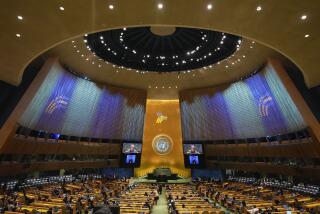The Moscow Summit : Doubts and Delays Stalled Accord on Strategic Missiles
- Share via
HELSINKI, Finland — Last summer’s bright hopes of signing an agreement to cut offensive strategic arms by half in time for the May summit, which opens in Moscow today, have faded to extinction. And, while U.S. officials expressed hope Saturday that such an accord might still be hammered out before President Reagan leaves office, there was more than enough blame to go around for not having the treaty completed by now.
The Soviets delayed for three months before submitting their draft treaty. In Washington,the Joint Chiefs of Staff suddenly dug in their heels against new U.S. offers.
And an errant comma, as some experts see it, ruined the fragile compromise on space defense that was reached at last December’s summit in Washington. About a dozen words were to have solved the impasse over the U.S. Strategic Defense Initiative--the “Star Wars” project--but the stray comma meant that the two sides could--and did--insist on opposite interpretations.
As a result, this week’s summit is likely to see the signing of only one or two minor new arms agreements and a ratification ceremony for the Intermediate-range Nuclear Forces (INF) Treaty signed last December.
The INF treaty, which bans ground-launched nuclear weapons with ranges of between 300 and 3,400 miles, won overwhelming approval in the U.S. Senate on Friday and was also approved by the Presidium, the executive committee of the Supreme Soviet or Parliament, on Saturday. Reagan and Soviet leader Mikhail S. Gorbachev will exchange instruments of ratification Wednesday.
The two new agreements likely to be completed are small steps toward eventual ratification of two treaties limiting underground nuclear tests that were signed more than a decade ago. Because of last-minute Soviet moves, the two sides were unable to come together on a third agreement--to provide for advance notification of missile test flights within national borders (international flights are covered).
Nonetheless, Reagan and Gorbachev have agreed in principle that their nuclear arsenals--the long-range missiles aimed at each other’s territory--should be cut by half. White House officials said Saturday that Reagan would be taking new proposals to Moscow.
Still, Administration and non-government experts in Washington have mixed emotions about the superpowers’ failure to complete work on all the details of such a far-reaching treaty. They feel the consequences of what has already been negotiated are not clear.
“Where are we going?” asked Brent Scowcroft, who was national security adviser to former Presidents Richard M. Nixon and Gerald R. Ford. “If 50% is good, is 75% better and 100% best? What then happens to the concept of nuclear deterrence? Where’s the line between good and bad?”
A strategic arms reduction talks (START) agreement, according to top Defense Department officials, would require U.S. defense planners to rethink their deployment of long-range nuclear weapons.
In political terms as well, a START treaty could be expected to generate stiff opposition, particularly from conservatives.
Despite the remaining obstacles to a START agreement, the two sides have in fact settled many of its central features. U.S. and Soviet negotiators in Geneva, who began work in 1982, have almost 300 pages of a draft treaty, mostly in language accepted by both sides.
Both sides have agreed to a ceiling of 1,600 delivery vehicles--land- and submarine-based ballistic missiles and heavy bombers--compared to today’s U.S. total of 1,974 and the Soviet Union’s 2,485. And both sides would limit weapons, warheads and bombs, to 6,000, compared to about 12,750 U.S. weapons and 10,650 Soviet weapons today.
But loopholes remain that could allow many more than the 6,000 limit. The major unresolved arms issues to be addressed center on:
-- Mobile land-based missiles. The United States has none and wants to ban them. The Soviets have two new types of this weapon and want to keep them. The Joint Chiefs would like to base the 50 U.S. MX missiles on moving rail cars and has resisted constraints on mobile missiles until Congress provides money for making the MX missiles mobile.
-- Air-launched cruise missiles. The Soviets, who are behind in this field, want to limit both conventional-armed and nuclear ALCMs that have a range of more than 375 miles. The U.S. proposal would limit only nuclear-armed ALCMs with a range of more than about 1,000 miles.
-- Sea-launched cruise missiles. Lagging here too, the Soviets want to limit long-range SLCMs, while Washington wants no fixed ceiling.
-- Verification. The two sides have agreed to measures that would be far more intrusive than those for monitoring compliance with the treaty banning medium-range missiles. Still unsettled are the problems of which missile sites would be open to inspection.
-- Space defenses. The Soviets insist that the Anti-Ballistic Missile Treaty severely limits the Administration’s controversial SDI program. The Administration, interpreting the treaty broadly, says it can do advance work toward an anti-missile shield.
At last December’s summit conference, the two sides tried to paper over the differences by calling for an agreement that would commit both sides to observing the ABM treaty “while conducting their research, development and testing as required, which is permitted by the ABM treaty.”
Afterward, Reagan said that this language resolved the issue in favor of the United States. Gorbachev called the U.S. interpretation dangerous and reiterated the Soviet view that the ABM treaty precludes testing in space of devices that could become SDI weaponry.
Helmut Sonnenfeldt, a national security aide in the Nixon and Ford administrations, said the comma separating the words required and which lent credence to the Soviet interpretation that some testing is permitted but some is not. Reagan Administration officials insist that the language means that all required testing is permitted.
More to Read
Sign up for Essential California
The most important California stories and recommendations in your inbox every morning.
You may occasionally receive promotional content from the Los Angeles Times.













